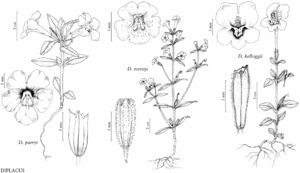Diplacus parryi
Phytoneuron 2012-39: 27. 2012.
Herbs, annual. Stems erect, 10–120(–170) mm, finely and minutely glandular-puberulent. Leaves usually cauline, relatively even-sized; petiole absent; blade narrowly elliptic to sublinear or oblanceolate, sometimes obovate, (5–)8–25(–31) × (1–)2–9(–12) mm, margins entire, plane, not ciliate, apex: proximals usually rounded, distals usually acute, surfaces glandular-puberulent. Pedicels (1.5–)2–4(–9) mm in fruit. Flowers 2 per node, or 1 or 2 per node on 1 plant, chasmogamous. Calyces symmetrically attached to pedicels, not inflated in fruit, (5–)7–12(–13) mm, glandular-puberulent, lobes unequal, adaxial longer, apex broadly rounded to acute, often apiculate, ribs often dark purple, intercostal areas purplish or white. Corollas of 2 color forms: (a) magenta, ± deepening at mouth, usually with 6–8 darker spots in arc on abaxial lip around mouth, throat floor yellow to whitish with reddish speckling and (b) yellow with 6–8 narrow reddish spots or lines in arc on abaxial lip around mouth and reddish speckling on throat floor, palate ridges yellow extending onto lip, tube-throat (10–)12–18(–20) mm, limb 11–17.5(–20) mm diam., not bilabiate. Anthers included, glabrous. Styles glandular-puberulent. Stigmas included, lobes equal. Capsules (5.5–)6.5–10.5 mm. 2n = 16.
Phenology: Flowering Apr–Jun(–Jul).
Habitat: Banks, gravel bars, washes, sandy ravines, rocky hillsides, ledges and bases of limestone ledges and boulders, clay loam-basalt, bare areas, often with Coleogyne and Larrea, sagebrush and pinyon-juniper.
Elevation: (600–)800–1700(–2200) m.
Distribution
Ariz., Calif., Nev., Utah.
Discussion
Diplacus parryi has a limited range, primarily in the Mohave Desert in four states: Arizona (Mohave County), California (Inyo County, where apparently disjunct, in pinyon-juniper woodlands, and at higher than typical elevation), Nevada (Clark and Lincoln counties), and Utah (Washington County). The glandular-puberulent vestiture and unequal calyx lobes are diagnostic.
Selected References
None.
